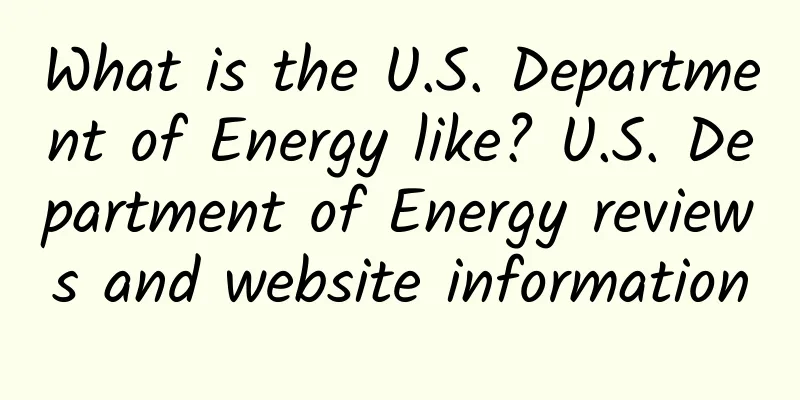What is the U.S. Department of Energy like? U.S. Department of Energy reviews and website information

|
What is the website of the United States Department of Energy? The United States Department of Energy (DOE) is a federal government agency of the United States. It was established in 1977 and is mainly responsible for energy policy formulation, energy-related technology research and development, weapons development, etc. It has many laboratories under it, including Argonne National Laboratory, Los Alamos National Laboratory, Fermi National Accelerator Laboratory, etc. Website: www.energy.gov The United States Department of Energy (DOE) is an important agency of the U.S. federal government. It was established in 1977 and is mainly responsible for the formulation of U.S. energy policies, the research and development of energy-related technologies, and the development and management of nuclear weapons. As the leading agency in the U.S. energy field, the U.S. Department of Energy plays a vital role in promoting national energy security, scientific and technological innovation, and environmental protection. Background of the establishment of the U.S. Department of EnergyThe establishment of the U.S. Department of Energy can be traced back to the energy crisis in the 1970s. In 1973, the Organization of Petroleum Exporting Countries (OPEC) announced an oil embargo, which caused a surge in global oil prices, tight energy supply in the United States, and a serious impact on the economy. This incident prompted the U.S. government to realize the importance of energy security and began to integrate energy-related functions to meet future energy challenges. On August 4, 1977, then-US President Jimmy Carter signed the Department of Energy Organization Act, formally establishing the US Department of Energy. The Act integrated energy-related functions that were previously scattered across multiple departments, including energy research, nuclear energy management, and energy policy formulation. The establishment of the US Department of Energy marked a major change in the US energy management system. The main responsibilities of the U.S. Department of EnergyThe main responsibilities of the U.S. Department of Energy cover energy policy, technology research and development, nuclear energy management, environmental protection and other fields. The following is a detailed description of its main functions: 1. Energy policy formulationThe U.S. Department of Energy is responsible for developing and implementing national energy policies to ensure energy security, economic prosperity, and environmental protection in the United States. The core goals of energy policy are to reduce dependence on fossil fuels, promote the development of clean and renewable energy, improve energy efficiency, and reduce the negative impact of energy consumption on the environment. The Department of Energy analyzes domestic and international energy market dynamics, assesses energy supply and demand, and formulates relevant policies to respond to energy crises and price fluctuations. In addition, the Department of Energy also cooperates with other federal agencies, state governments, the private sector, and international organizations to promote global energy governance. 2. Energy technology research and developmentThe U.S. Department of Energy has invested a lot of resources in energy technology research and development, and is committed to promoting scientific and technological innovation in the energy field. Many national laboratories and research centers under the Department of Energy enjoy a high reputation worldwide, such as Argonne National Laboratory, Los Alamos National Laboratory, and Fermi National Accelerator Laboratory. The Department of Energy's research and development work covers a variety of areas, including renewable energy (such as solar energy, wind energy, biomass energy), nuclear energy, fossil energy, energy storage technology, smart grid, energy efficiency technology, etc. By supporting basic research and applied research, the Department of Energy provides strong technical support for the energy transformation of the United States. 3. Nuclear energy managementThe U.S. Department of Energy is responsible for the research, development and management of nuclear energy, including the design and operation of nuclear power plants, nuclear waste disposal, nuclear weapons development and maintenance, etc. The Department of Energy, through its National Nuclear Security Administration (NNSA), is responsible for the development and maintenance of nuclear weapons to ensure the U.S. nuclear deterrence capability. In addition, the Department of Energy is responsible for the management and disposal of nuclear waste and is committed to developing safe and efficient nuclear waste treatment technologies to reduce the potential risks of nuclear energy to the environment and human health. 4. Environmental protectionThe U.S. Department of Energy also has important responsibilities in environmental protection. By promoting the development of clean and renewable energy, the Department of Energy is committed to reducing greenhouse gas emissions and addressing climate change. The Department of Energy also supports the research and development and promotion of energy efficiency technologies to help businesses and households reduce energy consumption and reduce environmental pollution. In addition, the Department of Energy is responsible for managing the disposal of nuclear waste and other hazardous wastes, ensuring that these wastes do not pose a threat to the environment and public health. Organizational Structure of the U.S. Department of EnergyThe U.S. Department of Energy has a complex and large organizational structure, including multiple offices, bureaus, and laboratories. The following is a brief introduction to its main components: 1. Minister’s OfficeThe Office of the Minister is the highest leadership body of the U.S. Department of Energy and is led by the Secretary of Energy. The Secretary of Energy is nominated by the President and appointed after approval by the Senate. He is responsible for leading the overall work of the Department of Energy and formulating and implementing national energy policies. The Office of the Minister is divided into several Assistant Ministers' Offices, which are responsible for work in the fields of energy policy, science and technology, nuclear energy management, and environmental protection. 2. National Nuclear Security Administration (NNSA)The National Nuclear Security Administration is an independent agency under the U.S. Department of Energy responsible for the development, maintenance and management of nuclear weapons. The main mission of NNSA is to ensure the United States' nuclear deterrence capability, prevent the proliferation of nuclear weapons, manage nuclear waste, and support the peaceful use of nuclear energy. 3. Energy Information Administration (EIA)The Energy Information Administration is the statistical and analytical agency of the U.S. Department of Energy, responsible for collecting, analyzing and publishing energy-related data. EIA's data and reports provide important decision-making basis for governments, businesses and the public, helping to understand the dynamics and trends of the energy market. 4. National LaboratoriesThe national laboratories under the U.S. Department of Energy are important bases for global energy research and technological innovation. These laboratories have carried out a large number of cutting-edge research in the fields of energy, nuclear energy, materials science, environmental science, etc., providing strong support for the energy transformation and technological innovation of the United States. The following are some of the national laboratories under the U.S. Department of Energy:
Key projects of the U.S. Department of EnergyThe U.S. Department of Energy has carried out a large number of important projects in many aspects of the energy field. The following are some of the representative projects: 1. Clean Energy PlanThe Clean Power Plan is an important initiative of the U.S. Department of Energy to promote the development of renewable energy and energy efficiency technologies. The plan aims to reduce dependence on fossil fuels, promote the development of clean energy such as solar energy, wind energy, and biomass energy, improve energy efficiency, and reduce greenhouse gas emissions. The Department of Energy helps businesses and local governments achieve energy transformation and promotes the commercial application of clean energy technologies by funding research projects, providing technical support and policy guidance. 2. Nuclear Energy Innovation ProgramThe Nuclear Innovation Program is an important project of the U.S. Department of Energy to promote the development of nuclear energy technology. The program aims to develop a new generation of nuclear reactor technology and improve the safety, economy and sustainability of nuclear energy. The Department of Energy promotes the important role of nuclear energy in the future energy system by supporting nuclear energy research, demonstration projects and commercial applications. 3. Energy storage technology research and developmentEnergy storage technology is the key to achieving large-scale application of renewable energy. The U.S. Department of Energy has invested a lot of resources in the research and development of energy storage technology, and is committed to developing efficient, low-cost, and long-life energy storage systems. The Department of Energy supports the research and development of various energy storage technologies such as battery technology, supercapacitors, and compressed air energy storage, and promotes the commercial application of energy storage technology. 4. Smart grid constructionSmart grid is an important part of the future energy system. The U.S. Department of Energy promotes the modernization and intelligence of the power grid through the Smart Grid Construction Program, and improves the reliability, safety and efficiency of the power grid. The Department of Energy supports the research and development and demonstration of smart grid technology and promotes the application of smart grids across the country. DOE's International CollaborationThe U.S. Department of Energy also plays an important role in global energy governance and international cooperation. The Department of Energy works with other countries and international organizations to promote global energy transformation, address climate change, and promote international cooperation and exchange of energy technologies. The U.S. Department of Energy maintains close cooperation with international organizations such as the International Energy Agency (IEA) and the International Atomic Energy Agency (IAEA), and participates in the formulation of global energy policies and technical standards. In addition, the Department of Energy has also carried out extensive cooperation with major economies such as China, the European Union, and Japan in the fields of energy technology research and development, clean energy development, and nuclear energy safety. The U.S. Department of Energy's influenceAs the leading agency in the U.S. energy sector, the U.S. Department of Energy plays an important role in energy policy formulation, technology research and development, nuclear energy management, etc. Through its national laboratories and research centers, the Department of Energy has promoted the research and application of a large number of cutting-edge technologies, providing strong support for the U.S. energy transformation and technological innovation. In addition, the U.S. Department of Energy has also played an important role in global energy governance and international cooperation, promoting global energy transformation and climate change response. Through cooperation with other countries and international organizations, the Department of Energy has made important contributions to global energy security and sustainable development. Future Outlook of the U.S. Department of EnergyWith the acceleration of global energy transformation and the increasing severity of climate change, the U.S. Department of Energy will face more challenges and opportunities in the future. The Department of Energy will continue to promote the development of clean and renewable energy, improve energy efficiency, reduce greenhouse gas emissions, and promote the innovation and application of energy technologies. In addition, the U.S. Department of Energy will continue to strengthen nuclear energy management to ensure the safety and sustainable development of nuclear energy. Through cooperation with other countries and international organizations, the Department of Energy will continue to promote global energy governance and make greater contributions to global energy security and sustainable development. In short, as the leading agency in the U.S. energy sector, the U.S. Department of Energy plays an important role in energy policy formulation, technology research and development, nuclear energy management, etc. Through its extensive work and influence, the Department of Energy has made important contributions to the energy security, economic prosperity and environmental protection of the United States, and will continue to promote global energy transformation and sustainable development in the future. |
<<: What is Shapeways like? Shapeways review and website information
>>: How is Deep Springs College? Deep Springs College reviews and website information
Recommend
How is Lan Gan Xing's university? Lan Gan Xing's university reviews and website information
What is the website of Ramkhamhaeng University? Ra...
Will eating guava cause internal heat? Taboos of eating guava
Guava is a fruit with a particularly high nutriti...
What is Galaxy Zoo like? Galaxy Zoo review and website information
What is Galaxy Zoo? Galaxy Zoo is a volunteer scie...
How to make Tremella and Chrysanthemum Soup How to make Tremella and Chrysanthemum Soup
Spring is here and the weather is dry. The temper...
The efficacy and function of Bagua
Bagua is also known as August melon. Now let us l...
Nutritional value and efficacy of black beans
Everyone has a certain understanding of black bea...
What is the National Tourism Office of Montenegro like? Reviews and website information of the National Tourism Office of Montenegro
What is the website of Montenegro National Tourism...
What foods can't people with allergies eat?
Physical allergies are a common condition that pe...
What are the disadvantages of eating too much mango?
Mango is a common tropical fruit. It is fleshy, s...
What is Pandora like? Pandora review and website information
What is Pandora? Pandora Jewelry is the world'...
The difference between Wogan and Huangdigan. Which is better, Huangdigan or Wogan?
Both Wogan and Huangdigan are common fruits in th...
What are the benefits of eating dried apples?
Dried apples are dried fruits obtained by dehydra...
Can pregnant women eat longan? What are the advantages and disadvantages of eating longan for pregnant women?
Longan is very nutritious, so can pregnant women ...
The nutritional value and efficacy of jujube paste
Date paste is a deep-processed product of red dat...
Can purple amaranth be eaten with cabbage? Is it good to eat purple amaranth and cabbage together?
Purple amaranth is a very common food in hot pot ...









